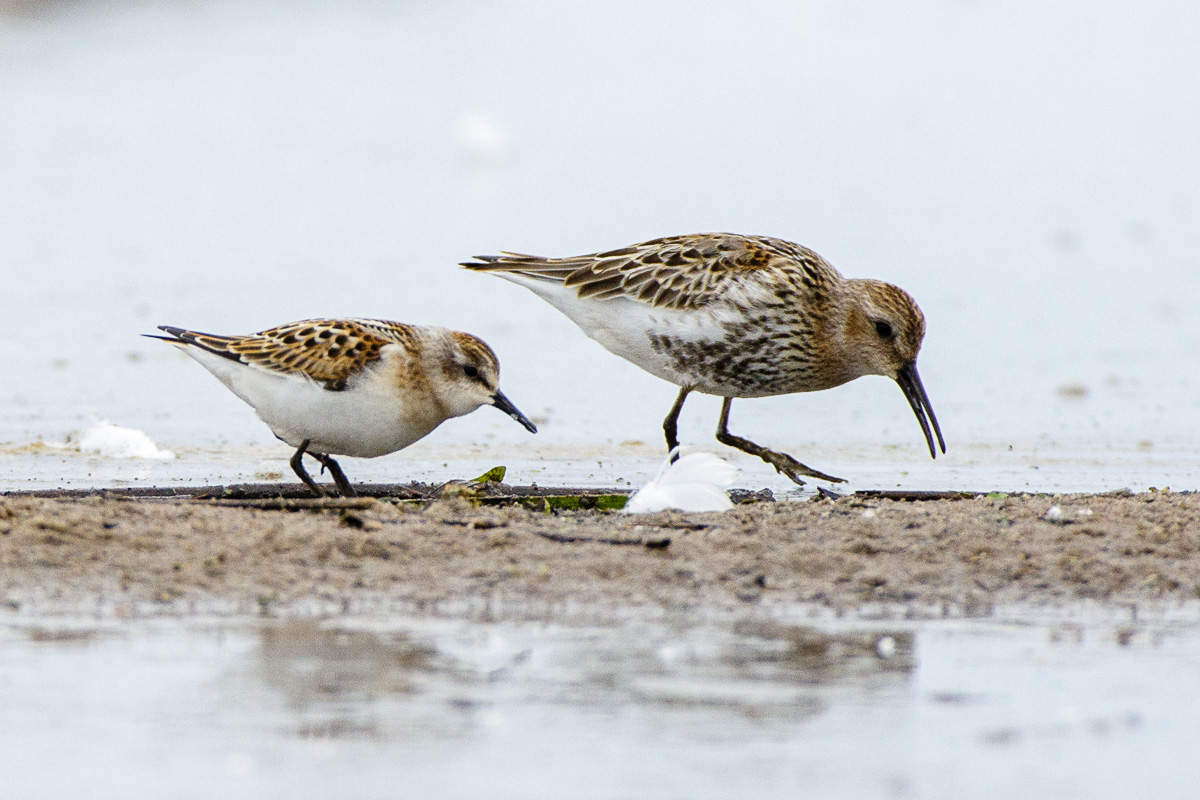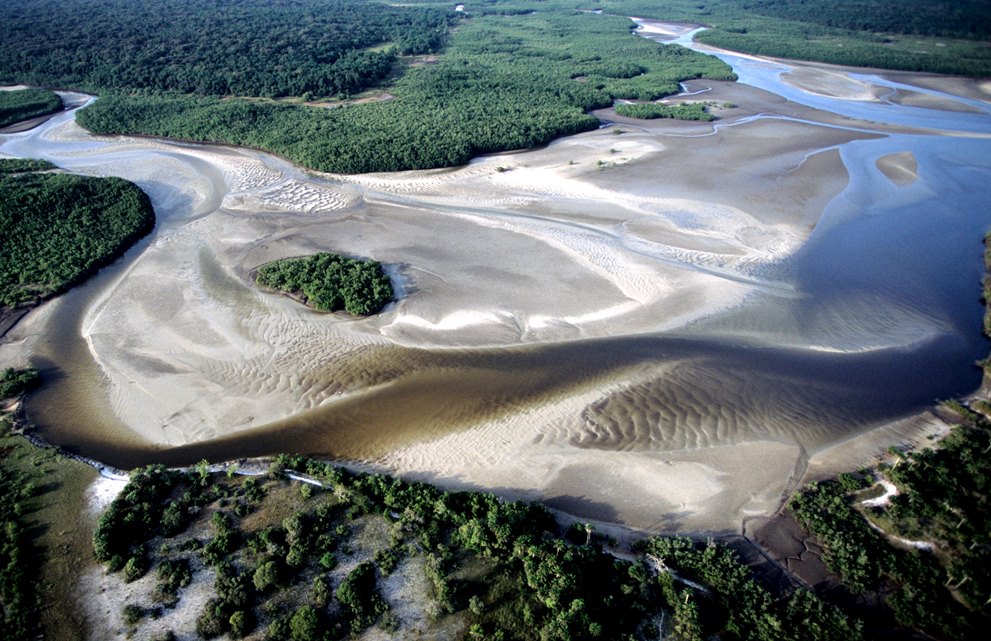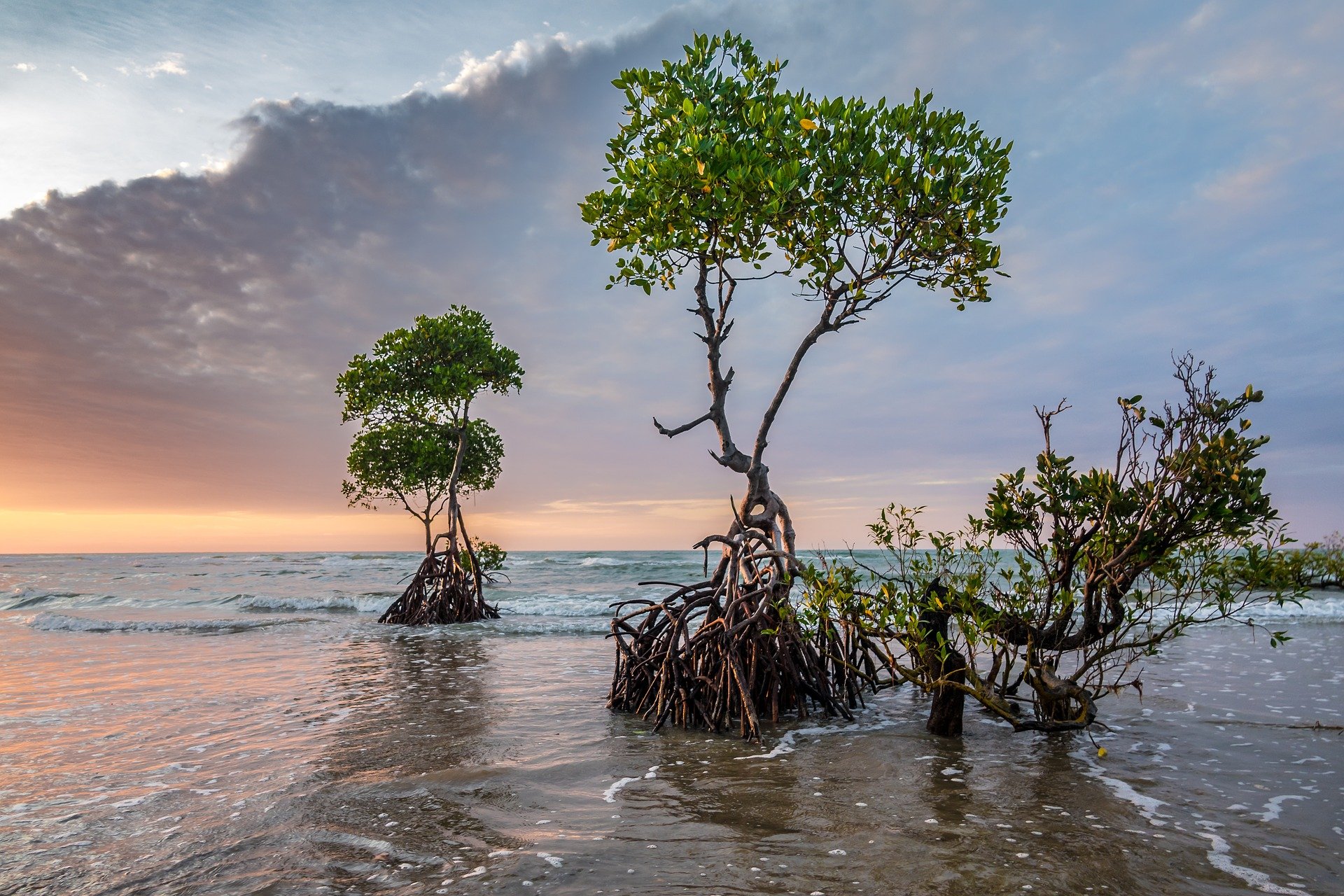|
Saloum Delta
Saloum Delta or Sine-Saloum Delta is a river delta in Senegal at the mouth of the Saloum River where it flows into the North Atlantic Ocean. The delta covers 180,000 hectares. It extends 72.5 kilometers along the coastline and 35 kilometers inland. In 2011, a 145,811-hectare portion of the delta was designated a UNESCO World Heritage Site. The site contains "brackish channels encompassing over 200 islands and islets, mangrove forest, an Atlantic marine environment, and dry forest." Saloum Delta National Park covers 76,000 hectares of the delta. The bird species that breed or winter in the area include royal tern, greater flamingo, Eurasian spoonbill, curlew sandpiper, ruddy turnstone, and little stint. Aside from being a valued breeding ground for birds Birds are a group of warm-blooded vertebrates constituting the class (biology), class Aves (), characterised by feathers, toothless beaked jaws, the Oviparity, laying of Eggshell, hard-shelled eggs, a high Metabolism, m ... [...More Info...] [...Related Items...] OR: [Wikipedia] [Google] [Baidu] |
Senegal
Senegal, officially the Republic of Senegal, is the westernmost country in West Africa, situated on the Atlantic Ocean coastline. It borders Mauritania to Mauritania–Senegal border, the north, Mali to Mali–Senegal border, the east, Guinea to Guinea–Senegal border, the southeast and Guinea-Bissau to Guinea-Bissau–Senegal border, the southwest. Senegal nearly surrounds The Gambia, a country occupying a narrow sliver of land along the banks of the Gambia River, which separates Senegal's southern region of Casamance from the rest of the country. It also shares a maritime border with Cape Verde. Senegal's capital is Dakar. Senegal is the westernmost country in the mainland of the Old World, or Afro-Eurasia. It owes its name to the Senegal River, which borders it to the east and north. The climate is typically Sahelian, though there is a wet season, rainy season. Senegal covers a land area of almost and has a population of around 18 million. The state is a Presidential system ... [...More Info...] [...Related Items...] OR: [Wikipedia] [Google] [Baidu] |
Royal Tern
The royal tern (''Thalasseus maximus'') is a tern in the family Laridae. The species is endemic to the Americas, though vagrants have been identified in Europe.Buckley, P. A. and F. G. Buckley (2020). Royal Tern (Thalasseus maximus), version 1.0. In Birds of the World (S. M. Billerman, Editor). Cornell Lab of Ornithology, Ithaca, NY, USA. https://doi.org/10.2173/bow.royter1.01 Retrieved April 17, 2021 Taxonomy The royal tern was described by the French polymath Georges-Louis Leclerc, Comte de Buffon in 1781 in his ''Histoire Naturelle des Oiseaux'' from a specimen collected in Cayenne, French Guiana. The bird was also illustrated in a hand-colored plate engraved by François-Nicolas Martinet in the ''Planches Enluminées D'Histoire Naturelle'' which was produced under the supervision of Edme-Louis Daubenton to accompany Buffon's text. Neither the plate caption nor Buffon's description included a scientific name but in 1783 the Dutch naturalist Pieter Boddaert coined the binomial ... [...More Info...] [...Related Items...] OR: [Wikipedia] [Google] [Baidu] |
World Heritage Sites In Senegal
The world is the totality of entities, the whole of reality, or everything that exists. The nature of the world has been conceptualized differently in different fields. Some conceptions see the world as unique, while others talk of a "plurality of worlds". Some treat the world as one simple object, while others analyze the world as a complex made up of parts. In scientific cosmology, the world or universe is commonly defined as "the totality of all space and time; all that is, has been, and will be". Theories of modality talk of possible worlds as complete and consistent ways how things could have been. Phenomenology, starting from the horizon of co-given objects present in the periphery of every experience, defines the world as the biggest horizon, or the "horizon of all horizons". In philosophy of mind, the world is contrasted with the mind as that which is represented by the mind. Theology conceptualizes the world in relation to God, for example, as God's creation, ... [...More Info...] [...Related Items...] OR: [Wikipedia] [Google] [Baidu] |
Birds
Birds are a group of warm-blooded vertebrates constituting the class (biology), class Aves (), characterised by feathers, toothless beaked jaws, the Oviparity, laying of Eggshell, hard-shelled eggs, a high Metabolism, metabolic rate, a four-chambered heart, and a strong yet lightweight Bird skeleton, skeleton. Birds live worldwide and range in size from the bee hummingbird to the common ostrich. There are over 11,000 living species and they are split into 44 Order (biology), orders. More than half are passerine or "perching" birds. Birds have Bird wing, wings whose development varies according to species; the only known groups without wings are the extinct moa and elephant birds. Wings, which are modified forelimbs, gave birds the ability to fly, although further evolution has led to the Flightless bird, loss of flight in some birds, including ratites, penguins, and diverse endemism, endemic island species. The digestive and respiratory systems of birds are also uniquely a ... [...More Info...] [...Related Items...] OR: [Wikipedia] [Google] [Baidu] |
Little Stint
The little stint (''Calidris minuta'' or ''Erolia minuta'') is a very small wader. It breeds in arctic Europe and Asia, and is a long-distance migrant, wintering south to Africa and south Asia. It occasionally is a vagrant to North America and to Australia. The genus name is from Ancient Greek ''kalidris'' or ''skalidris'', a term used by Aristotle for some grey-coloured waterside birds. The specific ''minuta'' is Latin for "small. Description Its small size, fine dark bill, dark legs and quicker movements distinguish this species from all waders except the other dark-legged stints. It can be distinguished from these in all plumages by its combination of a fine bill tip, unwebbed toes and long primary projection. The call is a sharp "stit". The breeding adult has an orange wash to the breast, a white throat and a strong white V on its back. In winter plumage identification is difficult. Juveniles have pale crown stripes and a pinkish breast. An apparent hybrid between this ... [...More Info...] [...Related Items...] OR: [Wikipedia] [Google] [Baidu] |
Ruddy Turnstone
The ruddy turnstone (''Arenaria interpres'') is a small Cosmopolitan distribution, cosmopolitan wader, wading bird, one of two species of turnstone in the genus ''Arenaria''. It is now classified in the sandpiper family Scolopacidae but was formerly sometimes placed in the plover family Charadriidae. It is a highly bird migration, migratory bird, breeding in northern parts of Palearctic, Eurasia and North America, and flying south to winter on coastlines almost worldwide. It is the only species of turnstone in much of its range and is often known simply as turnstone. Taxonomy The ruddy turnstone was Species description, formally described by the Swedish naturalist Carl Linnaeus in 1758 in the 10th edition of Systema Naturae, tenth edition of his ''Systema Naturae'' under the binomial nomenclature, binomial name ''Tringa interpres''. The species is now placed together with the black turnstone in the genus ''Arenaria (bird), Arenaria'' that was introduced by the French zoologist Ma ... [...More Info...] [...Related Items...] OR: [Wikipedia] [Google] [Baidu] |
Curlew Sandpiper
The curlew sandpiper (''Calidris ferruginea'') is a small wader that breeds on the tundra of Arctic Siberia. It is strongly bird migration, migratory, wintering mainly in Africa, but also in south and southeast Asia and in Australia and New Zealand. It is a Vagrancy (biology), vagrant to North America. Taxonomy The curlew sandpiper was species description, formally described in 1763 by the Danish author Erik Pontoppidan under the binomial name ''Tringa ferrugineus''. It is now placed with 23 other sandpipers in the genus ''Calidris'' that was introduced in 1804 by the German naturalist Blasius Merrem. The genus name is from Ancient Greek ''kalidris'' or ''skalidris'', a term used by Aristotle for some grey-coloured waterside birds. The specific ''ferruginea'' is from Latin ''ferrugo, ferruginis'', "iron rust" referring to its colour in breeding plumage. The curlew sandpiper is treated as monotypic: no subspecies are recognised. Within the genus ''Calidris'' the curlew sandpiper i ... [...More Info...] [...Related Items...] OR: [Wikipedia] [Google] [Baidu] |
Eurasian Spoonbill
The Eurasian spoonbill (''Platalea leucorodia''), or common spoonbill, is a wading bird of the ibis and spoonbill family Threskiornithidae, native to Europe, Africa and Asia. The species is partially migratory with the more northerly breeding populations mostly migrating south for the winter. Taxonomy The Eurasian spoonbill was Species description, formally described in 1758 by the Swedish naturalist Carl Linnaeus in the 10th edition of Systema Naturae, tenth edition of his ''Systema Naturae'' under the current binomial nomenclature, binomial name ''Platalea leucorodia''. Linnaeus cited works by earlier authors including the description and illustration by the English naturalist Eleazar Albin that was published in 1734. Linnaeus specified the type locality (biology), type locality as Europe but restricted it to Sweden in 1761. The genus name ''Platalea'' is Latin and means "broad", referring to the distinctive shape of the bill; the specific epithet ''leucorodia'' is from Ancient G ... [...More Info...] [...Related Items...] OR: [Wikipedia] [Google] [Baidu] |
Greater Flamingo
The greater flamingo (''Phoenicopterus roseus'') is the most widespread and largest species of the flamingo family. Common in the Old World, they are found in Northern (coastal) and Sub-Saharan Africa, the Indian Subcontinent (south of the Himalayas), the Middle East, the Levant, the Persian Gulf, the Gulf of Aden, the Red Sea, and the Mediterranean countries of Southern Europe. Taxonomy The greater flamingo was described by Peter Simon Pallas in 1811. It was previously thought to be the same species as the American flamingo (''Phoenicopterus ruber''), but because of coloring differences of its head, neck, body, and bill, the two flamingos are now most commonly considered separate species. The greater flamingo has no subspecies and is therefore monotypic. Description The greater flamingo is the largest living species of flamingo, averaging tall and weighing . The largest male flamingos have been recorded to be up to tall and to weigh . Most of the plumage is pinkish-whit ... [...More Info...] [...Related Items...] OR: [Wikipedia] [Google] [Baidu] |
Saloum Delta National Park
Saloum Delta National Park or Parc National du Delta du Saloum in Senegal, is a national park. Established in 1976, it is situated within the Saloum Delta at the juncture of the Saloum River and the North Atlantic. The park, which forms part of a UNESCO World Heritage Site and a Ramsar Convention site, lies within a biosphere reserve. Water comprises of the park, intertidal mangroves and saltwater vegetation cover , and savannah and forest cover . It lies on the East Atlantic Flyway. The bird species that breed or winter in the area include royal tern, greater flamingo, Eurasian spoonbill, curlew sandpiper, ruddy turnstone, and little stint. This region represents an important synergy between nature with extensive biodiversity and the way of human development, which is still present, albeit fragile. Sustainable shellfish farming is highly developed here and is a very important source of food and export revenue for the local community and Senegal in general. The Saloum ... [...More Info...] [...Related Items...] OR: [Wikipedia] [Google] [Baidu] |
Ramsar Convention
The Ramsar Convention on Wetlands of International Importance Especially as Waterfowl Habitat is an international treaty for the conservation and sustainable use of Ramsar site, Ramsar sites (wetlands). It is also known as the Convention on Wetlands. It is named after the city of Ramsar, Mazandaran, Ramsar in Iran, where the convention was signed in 1971. Every three years, representatives of the contracting parties meet as the Ramsar Convention#Conference of the Contracting Parties, Conference of the Contracting Parties (COP), the policy-making organ of the wetland conservation, convention which adopts decisions (site designations, resolutions and recommendations) to administer the work of the convention and improve the way in which the parties are able to implement its objectives. In 2022, COP15 was held in Montreal, Canada. List of wetlands of international importance The list of wetlands of international importance included 2,531 Ramsar site, Ramsar sites in Februa ... [...More Info...] [...Related Items...] OR: [Wikipedia] [Google] [Baidu] |
Mangrove Forest
Mangrove forests, also called mangrove swamps, mangrove thickets or mangals, are productive wetlands that occur in coastal intertidal zones. Mangrove forests grow mainly at tropical and subtropical latitudes because mangrove trees cannot withstand freezing temperatures. There are about 80 different species of mangroves, all of which grow in areas with low-oxygen soil, where slow-moving waters allow fine sediments to accumulate.What is a mangrove forest? National Ocean Service, NOAA. Updated: 25 March 2021. Retrieved: 4 October 2021. Many mangrove forests can be recognised by their dense tangle of prop roots that make the trees appear to be standing on stilts above the water. This tangle of roots allows the trees to handle the daily rise and fall of tides, as most mangroves get flooded at least twice per day. The roo ... [...More Info...] [...Related Items...] OR: [Wikipedia] [Google] [Baidu] |








